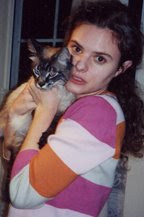 In Norse Mythology, three creatures control the destiny of humankind. They are the Norns, and correspond the Greek Moirai and Roman Percae. They are known by the names of "Urd," she who has become, "Verdandi," she who is becoming, and "Skuld," she who shall become. They live amongst the roots of Yggdrasil, the world tree, where they weave the tapestry of Fate. Each person's life is a string in their loom, and the length of that string equals the length of the person's life.
In Norse Mythology, three creatures control the destiny of humankind. They are the Norns, and correspond the Greek Moirai and Roman Percae. They are known by the names of "Urd," she who has become, "Verdandi," she who is becoming, and "Skuld," she who shall become. They live amongst the roots of Yggdrasil, the world tree, where they weave the tapestry of Fate. Each person's life is a string in their loom, and the length of that string equals the length of the person's life.Thence come the maids
Who much do know;
Three from the hall
Beneath the tree;
One they named Was,
And Being next,
The third Shall be.
-The Voluspa quoted in Bulfinch's Mythology
In addition to watering Yggdrasil and placing fresh clay around its roots, the Norns care for two swans swimming over the mirror-like surface of the Urdar (fate/wisdom) fountain. All swans are thought to be descended from this pair. The Norns also sometimes appear in swan plumage to visit the earth and foretell the future.
Sometimes the Norns are referred to as Vala or prophetesses. According to Bulfinch’s Mythology, "one of the weavers stood on a high mountain in the extreme east, while another waded far out into the western sea. The threads of their woof resembled cords, and varied greatly in hue, according to the nature of the events about to occur." Because of this, clouds and the northern lights, or aurora borealis, were thought to be the very strands of the web woven by the Norns.
Nørn, a Swiss vocal trio, image from www.norn.ch.










